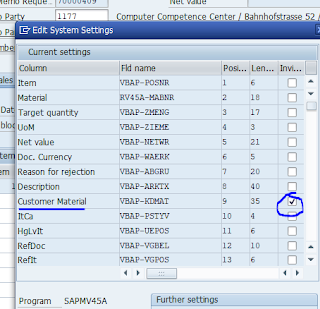While creating a sales order, there are many fields defaulted from Master Data at both Header and items
( such as incoterms,
payment terms,
Plant ,
Availability check
Customer Material Number)
and few fields determined from Configuration such as
Item Category determination
Pricing procedure
Shipping point
and so on...
It is not necessary to have all the master Data fields to be populated to sales order. We can control the layout of Sales order , so few fields which are not necessary to get populated can be ignored from appearing on Sales order
In the sales order -Item, we can check how this can be controlled
Let us assume, that i dont want to show CUSTOMER MATERIAL NUMBER at line item level on Sales order
For this, Click on Table Configuration at Item level --Administration level, choose CUSTOMER MATERIAL field and select the indicator as INVISIBLE
Save it and when you create a sales order further, Customer material number field will be invisible
like this , we can disable which ever the field is not required for us to get displayed in Sales Order
In S4HANA, using Screen Persona, this can be done for Fiori Apps
( such as incoterms,
payment terms,
Plant ,
Availability check
Customer Material Number)
and few fields determined from Configuration such as
Item Category determination
Pricing procedure
Shipping point
and so on...
It is not necessary to have all the master Data fields to be populated to sales order. We can control the layout of Sales order , so few fields which are not necessary to get populated can be ignored from appearing on Sales order
In the sales order -Item, we can check how this can be controlled
Let us assume, that i dont want to show CUSTOMER MATERIAL NUMBER at line item level on Sales order
For this, Click on Table Configuration at Item level --Administration level, choose CUSTOMER MATERIAL field and select the indicator as INVISIBLE
Save it and when you create a sales order further, Customer material number field will be invisible
like this , we can disable which ever the field is not required for us to get displayed in Sales Order
In S4HANA, using Screen Persona, this can be done for Fiori Apps



Comments
Post a Comment